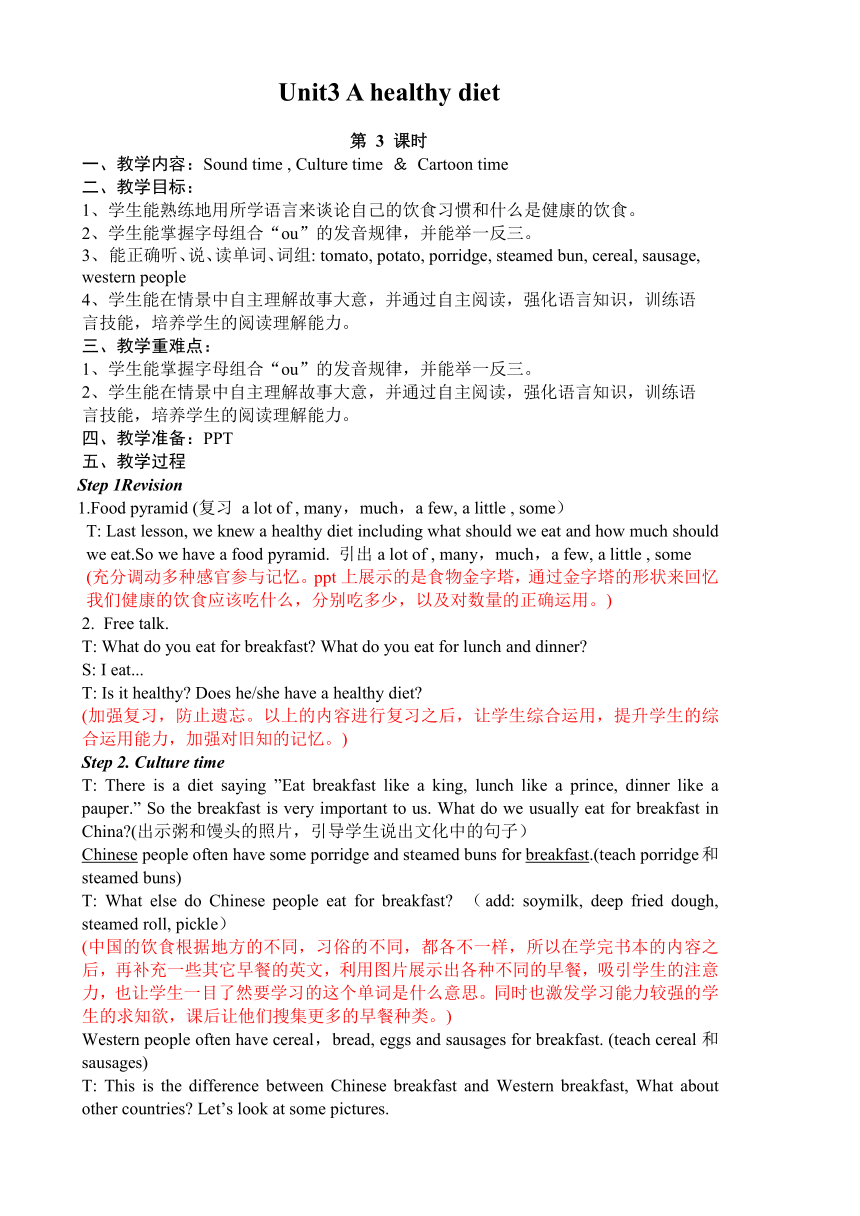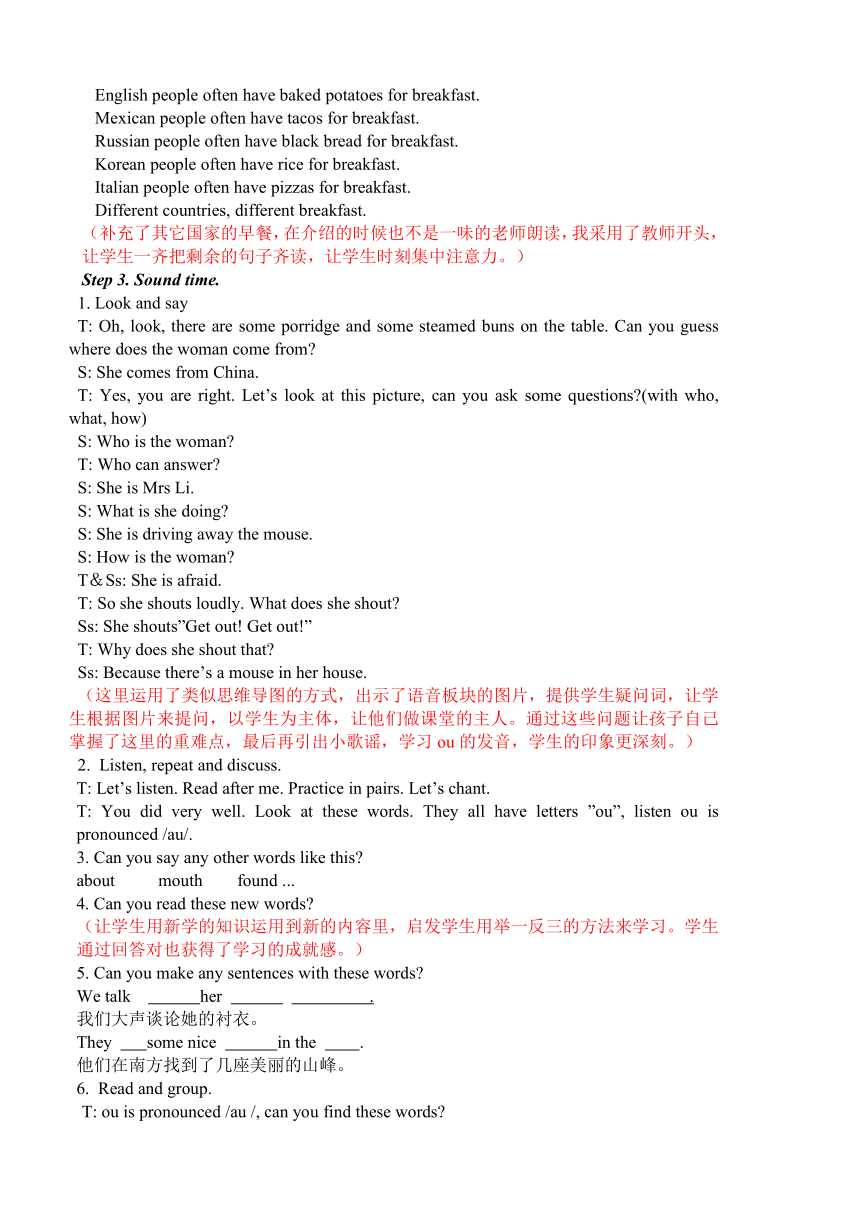Unit3 A healthy diet 第3课时教案
文档属性
| 名称 | Unit3 A healthy diet 第3课时教案 |  | |
| 格式 | doc | ||
| 文件大小 | 391.0KB | ||
| 资源类型 | 教案 | ||
| 版本资源 | 牛津译林版 | ||
| 科目 | 英语 | ||
| 更新时间 | 2022-04-06 08:50:37 | ||
图片预览


文档简介
Unit3 A healthy diet
第 3 课时
一、教学内容:Sound time , Culture time & Cartoon time
二、教学目标:
1、学生能熟练地用所学语言来谈论自己的饮食习惯和什么是健康的饮食。
2、学生能掌握字母组合“ou”的发音规律,并能举一反三。
3、 能正确听、说、读单词、词组: tomato, potato, porridge, steamed bun, cereal, sausage, western people
4、学生能在情景中自主理解故事大意,并通过自主阅读,强化语言知识,训练语言技能,培养学生的阅读理解能力。
三、教学重难点:
1、学生能掌握字母组合“ou”的发音规律,并能举一反三。
2、学生能在情景中自主理解故事大意,并通过自主阅读,强化语言知识,训练语言技能,培养学生的阅读理解能力。
四、教学准备:PPT
五、教学过程
Step 1Revision
1.Food pyramid (复习 a lot of , many,much,a few, a little , some)
T: Last lesson, we knew a healthy diet including what should we eat and how much should we eat.So we have a food pyramid. 引出a lot of , many,much,a few, a little , some
(充分调动多种感官参与记忆。ppt上展示的是食物金字塔,通过金字塔的形状来回忆我们健康的饮食应该吃什么,分别吃多少,以及对数量的正确运用。)
2. Free talk.
T: What do you eat for breakfast What do you eat for lunch and dinner
S: I eat...
T: Is it healthy Does he/she have a healthy diet
(加强复习,防止遗忘。以上的内容进行复习之后,让学生综合运用,提升学生的综合运用能力,加强对旧知的记忆。)
Step 2. Culture time
T: There is a diet saying ”Eat breakfast like a king, lunch like a prince, dinner like a pauper.” So the breakfast is very important to us. What do we usually eat for breakfast in China (出示粥和馒头的照片,引导学生说出文化中的句子)
Chinese people often have some porridge and steamed buns for breakfast.(teach porridge和steamed buns)
T: What else do Chinese people eat for breakfast (add: soymilk, deep fried dough, steamed roll, pickle)
(中国的饮食根据地方的不同,习俗的不同,都各不一样,所以在学完书本的内容之后,再补充一些其它早餐的英文,利用图片展示出各种不同的早餐,吸引学生的注意力,也让学生一目了然要学习的这个单词是什么意思。同时也激发学习能力较强的学生的求知欲,课后让他们搜集更多的早餐种类。)
Western people often have cereal,bread, eggs and sausages for breakfast. (teach cereal和sausages)
T: This is the difference between Chinese breakfast and Western breakfast, What about other countries Let’s look at some pictures.
English people often have baked potatoes for breakfast.
Mexican people often have tacos for breakfast.
Russian people often have black bread for breakfast.
Korean people often have rice for breakfast.
Italian people often have pizzas for breakfast.
Different countries, different breakfast.
(补充了其它国家的早餐,在介绍的时候也不是一味的老师朗读,我采用了教师开头,让学生一齐把剩余的句子齐读,让学生时刻集中注意力。)
Step 3. Sound time.
1. Look and say
T: Oh, look, there are some porridge and some steamed buns on the table. Can you guess where does the woman come from
S: She comes from China.
T: Yes, you are right. Let’s look at this picture, can you ask some questions (with who, what, how)
S: Who is the woman
T: Who can answer
S: She is Mrs Li.
S: What is she doing
S: She is driving away the mouse.
S: How is the woman
T&Ss: She is afraid.
T: So she shouts loudly. What does she shout
Ss: She shouts”Get out! Get out!”
T: Why does she shout that
Ss: Because there’s a mouse in her house.
(这里运用了类似思维导图的方式,出示了语音板块的图片,提供学生疑问词,让学生根据图片来提问,以学生为主体,让他们做课堂的主人。通过这些问题让孩子自己掌握了这里的重难点,最后再引出小歌谣,学习ou的发音,学生的印象更深刻。)
2. Listen, repeat and discuss.
T: Let’s listen. Read after me. Practice in pairs. Let’s chant.
T: You did very well. Look at these words. They all have letters ”ou”, listen ou is pronounced /au/.
3. Can you say any other words like this
about mouth found ...
4. Can you read these new words
(让学生用新学的知识运用到新的内容里,启发学生用举一反三的方法来学习。学生通过回答对也获得了学习的成就感。)
5. Can you make any sentences with these words
We talk her .
我们大声谈论她的衬衣。
They some nice in the .
他们在南方找到了几座美丽的山峰。
6. Read and group.
T: ou is pronounced /au /, can you find these words
T: ou can also be pronounced / /
Let’s read them together.
(在高年级的语音学习板块,学生有单个字母的发音逐步学习到字母组合的发音,但往往辨音的时候都是这些相同字母组合的不同发音进行辨别,所以设计了这一个环节,补充了ou的另一个发音,让学生及时积累。)
Step 3 Cartoon time
1.Lead in
Mrs Li doesn't like a mouse.
But we have a mouse friend, who's he
Who's his best friend in the book
Is Sam free now
2. Watch and answer.
T: Where are Sam and his mum
At home
In the supermarket
Near the river
(在观看动画前设置了一个大方向性的简单的问题,让学生先初步了解这个故事,有欲望继续学习下去。)
3. At home
T: Now they are at home. Why do they want to go to the supermarket Listen and find.(p1)
S: Because there’s not much food in the fridge.
4. In the supermarket
T: Then, they go to the supermarket. What do they buy there
S: Cola, rice and fish.
T: How much cola do they buy (Listen p2 让学生找答案回答。)
a small bottle→ a little
How much rice do they buy (Listen p4 让学生找答案回答。)
a big bag of the rice→ a lot of
How much fish do they buy (Listen p3 让学生找答案回答。)
5. Near the river
T: Next, they are going home. They are near the river. What’s wrong with the fish Listen and find.(p5,6)
(把课文分割成三个部分,再为每个部分设置不同的问题让学生通过自读、讨论的方式来得出答案,彻底解决了这个课文中的难点和重点。)
6. Read and imitate
T: It’s an interesting story. Let’s read after the tape.
7. Act the story
8. Add the title
T: Can you add the title for the story
9. Add the end
T: What will happen
(让这个课文的故事变得有延续性,让学生充分发挥他们的想象力,把课文的结尾补充完整,变成一个更富有趣味性的故事,增长了学生的学习兴趣,也有益于记忆课文。)
S: Let’s catch the fish with a large net.
六、板书设计
PAGE
第 3 课时
一、教学内容:Sound time , Culture time & Cartoon time
二、教学目标:
1、学生能熟练地用所学语言来谈论自己的饮食习惯和什么是健康的饮食。
2、学生能掌握字母组合“ou”的发音规律,并能举一反三。
3、 能正确听、说、读单词、词组: tomato, potato, porridge, steamed bun, cereal, sausage, western people
4、学生能在情景中自主理解故事大意,并通过自主阅读,强化语言知识,训练语言技能,培养学生的阅读理解能力。
三、教学重难点:
1、学生能掌握字母组合“ou”的发音规律,并能举一反三。
2、学生能在情景中自主理解故事大意,并通过自主阅读,强化语言知识,训练语言技能,培养学生的阅读理解能力。
四、教学准备:PPT
五、教学过程
Step 1Revision
1.Food pyramid (复习 a lot of , many,much,a few, a little , some)
T: Last lesson, we knew a healthy diet including what should we eat and how much should we eat.So we have a food pyramid. 引出a lot of , many,much,a few, a little , some
(充分调动多种感官参与记忆。ppt上展示的是食物金字塔,通过金字塔的形状来回忆我们健康的饮食应该吃什么,分别吃多少,以及对数量的正确运用。)
2. Free talk.
T: What do you eat for breakfast What do you eat for lunch and dinner
S: I eat...
T: Is it healthy Does he/she have a healthy diet
(加强复习,防止遗忘。以上的内容进行复习之后,让学生综合运用,提升学生的综合运用能力,加强对旧知的记忆。)
Step 2. Culture time
T: There is a diet saying ”Eat breakfast like a king, lunch like a prince, dinner like a pauper.” So the breakfast is very important to us. What do we usually eat for breakfast in China (出示粥和馒头的照片,引导学生说出文化中的句子)
Chinese people often have some porridge and steamed buns for breakfast.(teach porridge和steamed buns)
T: What else do Chinese people eat for breakfast (add: soymilk, deep fried dough, steamed roll, pickle)
(中国的饮食根据地方的不同,习俗的不同,都各不一样,所以在学完书本的内容之后,再补充一些其它早餐的英文,利用图片展示出各种不同的早餐,吸引学生的注意力,也让学生一目了然要学习的这个单词是什么意思。同时也激发学习能力较强的学生的求知欲,课后让他们搜集更多的早餐种类。)
Western people often have cereal,bread, eggs and sausages for breakfast. (teach cereal和sausages)
T: This is the difference between Chinese breakfast and Western breakfast, What about other countries Let’s look at some pictures.
English people often have baked potatoes for breakfast.
Mexican people often have tacos for breakfast.
Russian people often have black bread for breakfast.
Korean people often have rice for breakfast.
Italian people often have pizzas for breakfast.
Different countries, different breakfast.
(补充了其它国家的早餐,在介绍的时候也不是一味的老师朗读,我采用了教师开头,让学生一齐把剩余的句子齐读,让学生时刻集中注意力。)
Step 3. Sound time.
1. Look and say
T: Oh, look, there are some porridge and some steamed buns on the table. Can you guess where does the woman come from
S: She comes from China.
T: Yes, you are right. Let’s look at this picture, can you ask some questions (with who, what, how)
S: Who is the woman
T: Who can answer
S: She is Mrs Li.
S: What is she doing
S: She is driving away the mouse.
S: How is the woman
T&Ss: She is afraid.
T: So she shouts loudly. What does she shout
Ss: She shouts”Get out! Get out!”
T: Why does she shout that
Ss: Because there’s a mouse in her house.
(这里运用了类似思维导图的方式,出示了语音板块的图片,提供学生疑问词,让学生根据图片来提问,以学生为主体,让他们做课堂的主人。通过这些问题让孩子自己掌握了这里的重难点,最后再引出小歌谣,学习ou的发音,学生的印象更深刻。)
2. Listen, repeat and discuss.
T: Let’s listen. Read after me. Practice in pairs. Let’s chant.
T: You did very well. Look at these words. They all have letters ”ou”, listen ou is pronounced /au/.
3. Can you say any other words like this
about mouth found ...
4. Can you read these new words
(让学生用新学的知识运用到新的内容里,启发学生用举一反三的方法来学习。学生通过回答对也获得了学习的成就感。)
5. Can you make any sentences with these words
We talk her .
我们大声谈论她的衬衣。
They some nice in the .
他们在南方找到了几座美丽的山峰。
6. Read and group.
T: ou is pronounced /au /, can you find these words
T: ou can also be pronounced / /
Let’s read them together.
(在高年级的语音学习板块,学生有单个字母的发音逐步学习到字母组合的发音,但往往辨音的时候都是这些相同字母组合的不同发音进行辨别,所以设计了这一个环节,补充了ou的另一个发音,让学生及时积累。)
Step 3 Cartoon time
1.Lead in
Mrs Li doesn't like a mouse.
But we have a mouse friend, who's he
Who's his best friend in the book
Is Sam free now
2. Watch and answer.
T: Where are Sam and his mum
At home
In the supermarket
Near the river
(在观看动画前设置了一个大方向性的简单的问题,让学生先初步了解这个故事,有欲望继续学习下去。)
3. At home
T: Now they are at home. Why do they want to go to the supermarket Listen and find.(p1)
S: Because there’s not much food in the fridge.
4. In the supermarket
T: Then, they go to the supermarket. What do they buy there
S: Cola, rice and fish.
T: How much cola do they buy (Listen p2 让学生找答案回答。)
a small bottle→ a little
How much rice do they buy (Listen p4 让学生找答案回答。)
a big bag of the rice→ a lot of
How much fish do they buy (Listen p3 让学生找答案回答。)
5. Near the river
T: Next, they are going home. They are near the river. What’s wrong with the fish Listen and find.(p5,6)
(把课文分割成三个部分,再为每个部分设置不同的问题让学生通过自读、讨论的方式来得出答案,彻底解决了这个课文中的难点和重点。)
6. Read and imitate
T: It’s an interesting story. Let’s read after the tape.
7. Act the story
8. Add the title
T: Can you add the title for the story
9. Add the end
T: What will happen
(让这个课文的故事变得有延续性,让学生充分发挥他们的想象力,把课文的结尾补充完整,变成一个更富有趣味性的故事,增长了学生的学习兴趣,也有益于记忆课文。)
S: Let’s catch the fish with a large net.
六、板书设计
PAGE
